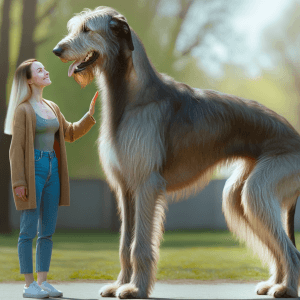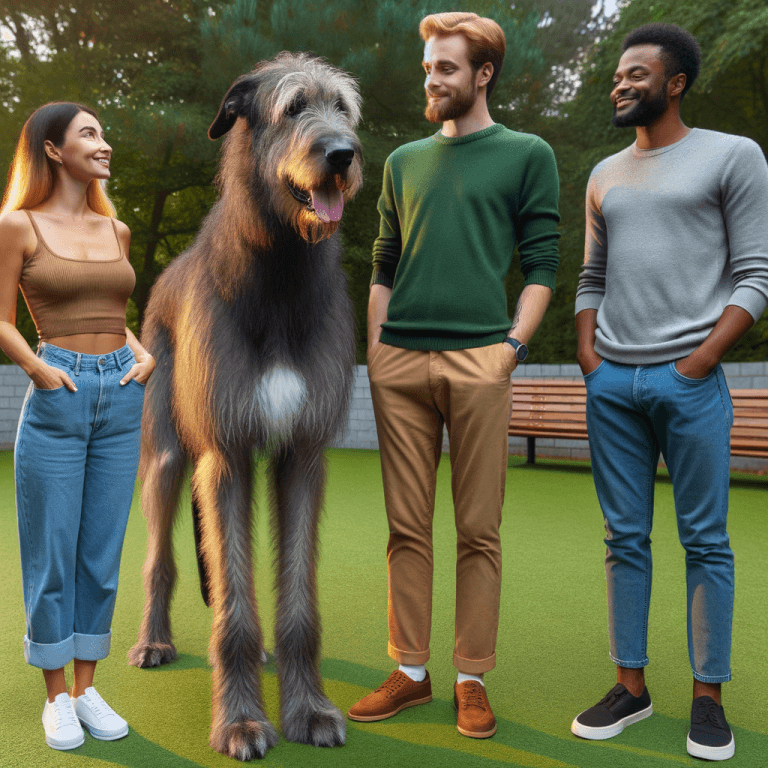Discovering the Irish Wolfhound
Ever wondered how the Irish Wolfhound compares to a human? Let’s explore their size, characteristics, history, and care needs. From their towering height and weight to their hunting and guarding abilities, there’s so much to learn about these majestic creatures. Stick around for some tips on how to care for and maintain these gentle giants!
Irish Wolfhound Size Comparison: How Do They Measure Up to Humans?
Discover the surprising similarities and differences between the majestic Irish Wolfhound and the average human in terms of height and weight. You won’t believe how these gentle giants stack up against us!
Irish Wolfhound Size
When it comes to the size of an Irish Wolfhound, it’s truly remarkable. On average, an adult male Irish Wolfhound stands at a towering 32 inches (81 cm) at the shoulder, while the average female measures around 30 inches (76 cm). In terms of weight, these majestic creatures typically weigh between 140-180 pounds (64-82 kg) for males and 115-140 pounds (52-64 kg) for females. To put this into perspective, the average height of a human male in the US is around 5 feet 9 inches (175 cm), and the average weight is approximately 197 pounds (89 kg). As you can see, the Irish Wolfhound is truly a giant among dogs!
Irish Wolfhound Characteristics
Irish Wolfhounds are known for their impressive physical and behavioral characteristics, making them unique and fascinating animals. Here are some key aspects of their nature:
Physical Characteristics
- Size: The Irish Wolfhound is one of the tallest dog breeds, with an average height of 32-34 inches (81-86 cm) for males and 30 inches (76 cm) for females. This makes them comparable in size to a human when standing on their hind legs.
- Strength: Their muscular build and strong frame allow them to be powerful and agile, making them excellent hunters and guardians.
- Coat: Their rough and wiry coat provides protection from harsh weather conditions, making them well-suited for outdoor activities.
Behavioral Characteristics
- Hunting Abilities: Irish Wolfhounds have a strong prey drive and were historically used for hunting wolves and other large game. Their keen sense of sight and speed make them formidable hunters.
- Guarding Abilities: Despite their gentle nature, Irish Wolfhounds are protective of their families and can act as effective guard dogs when needed.
- Temperament: They are known for their gentle and affectionate demeanor, making them great companions for families and individuals alike.
These characteristics make the Irish Wolfhound a remarkable breed with a rich history and unique qualities that set them apart from other dogs.
 Irish Wolfhound History
Irish Wolfhound History
Irish Wolfhounds have a rich historical significance, dating back to ancient times. They were originally bred for hunting and guarding purposes, and their impressive size and strength made them well-suited for these roles. The history of the Irish Wolfhound can be traced back to the Celts in Ireland, where they were highly valued for their hunting prowess and loyalty.
Origins and Past Uses
The Irish Wolfhound has a fascinating history, with origins dating back to 273 BC. They were used by the Celts for hunting wolves, boars, and even deer. Their large size and agility made them formidable hunters, and they were highly prized for their ability to protect their owners and their livestock.
Irish Wolfhounds were also used in battles, where their imposing presence and strength made them valuable assets on the battlefield. Their historical significance is evident in their portrayal in ancient artwork and literature, where they are often depicted as symbols of nobility and strength.
Today, Irish Wolfhounds are cherished for their gentle nature and loyal companionship, but their historical significance as skilled hunters and guardians is an important part of their legacy.
Irish Wolfhound Care and Maintenance
Caring for an Irish Wolfhound is essential to ensure their health and well-being. Here are some tips for maintaining and caring for these majestic dogs:
Dietary Needs
– Irish Wolfhounds require a high-quality diet to support their large size and energy levels.
– A balanced diet of protein, carbohydrates, and essential nutrients is crucial for their overall health.
– Feeding them in smaller, frequent meals can help prevent bloating, a common issue in large breeds.
Exercise Requirements
– Regular exercise is vital for Irish Wolfhounds to maintain their muscle tone and prevent obesity.
– Daily walks and ample space to run and play are necessary for their physical and mental well-being.
– Engaging in activities such as hiking or agility training can help fulfill their exercise needs.
Grooming
– Their dense, wiry coat requires regular brushing to prevent matting and remove loose hair.
– Bathing should be done as needed, using a gentle shampoo to maintain their coat’s natural oils.
– Regular nail trimming, ear cleaning, and dental care are essential for their overall hygiene.
Health Care
– Regular veterinary check-ups are crucial to monitor their health and address any potential issues.
– Vaccinations, parasite control, and preventive care are essential to ensure their well-being.
– Being aware of common health issues in Irish Wolfhounds, such as heart problems and joint issues, can help in early detection and treatment.
By providing proper care, nutrition, and attention, Irish Wolfhounds can thrive and make wonderful companions for those willing to invest in their well-being.
Conclusion
In conclusion, the Irish Wolfhound is a remarkable breed with a rich history and unique characteristics. From their impressive size to their gentle nature, Irish Wolfhounds are truly one-of-a-kind. It is important to consider the specific needs and care requirements of this breed before deciding to adopt one. With proper care and attention, an Irish Wolfhound can make a wonderful addition to any family.
For those interested in learning more about Irish Wolfhounds, further research is encouraged. Whether it be through books, online resources, or speaking with breeders and owners, there is always more to discover about this fascinating breed.


Comments are closed.